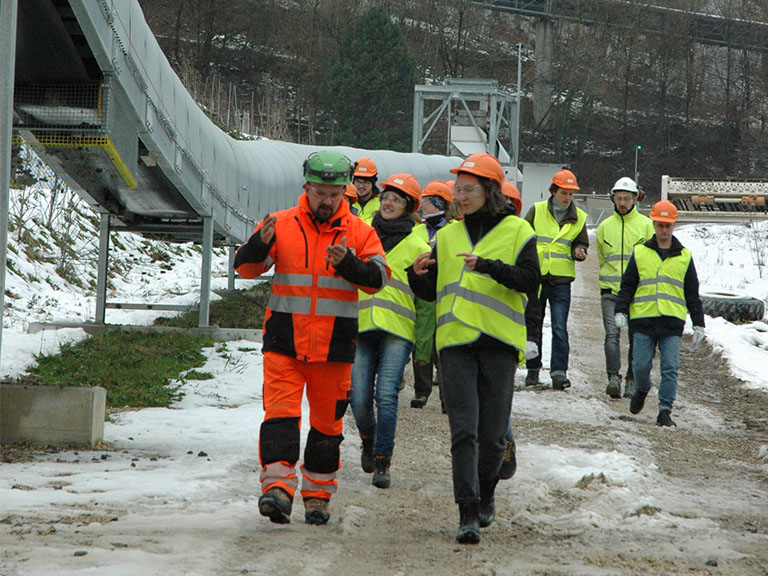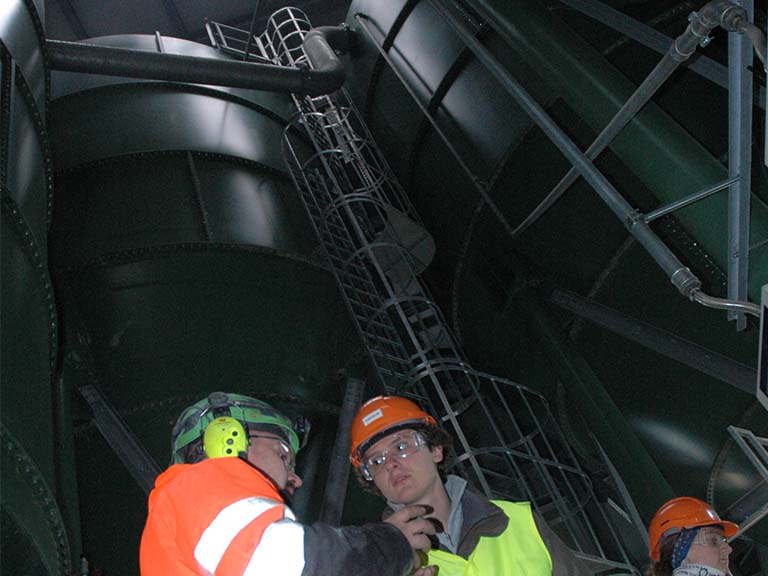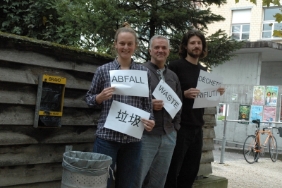Sustainable teaching
Construction waste is the concrete of tomorrow
Ninety percent of our waste consists of excavated and demolished material from construction sites, roads and buildings. Geology students learn on site how to conserve resources, the landscape and the climate using new methods of the circular economy.

It smells like a dusty dirt road in midsummer. But it’s bitterly cold all around us, we’re in a modern industrial building. Broad conveyor belts rumble as they transport gravel of various grain sizes past us. Watery sand flows from a yellow, vertically mounted metal spiral into the lower level.
Next to it, a structure shakes compact, black soil until it breaks down into small chunks. Across five floors, excavated material, road waste and drilling sludge are processed in the gray Vito Recycling AG building. This joint venture between the cement manufacturer Vigier AG and the construction and demolition company Toggenburger AG in Péry (BE) focuses on gravel and soil that first have to be detoxified due to their contamination with heavy metals or organic pollutants.
Switzerland’s most state-of-the-art soil washing plant
This state-of-the-art soil washing plant in Switzerland went into operation six months ago. “The process is designed for 130 metric tons of material per day, but at the moment we are only at a quarter of the capacity,” says Gérard Tschanz. The facility manager guides the 20 master’s students of the Waste Materials and Circular Economy course at the Institute of Geological Sciences through the noisy and vibrating hall.
It is only possible to ask questions again and have the multi-stage process explained to you once you are back outside: The excavated material is brought here by trucks from all over the region. A complex interplay of sorting and washing processes uses magnets, eddy current separators and other machines to separate out impurities such as metals, wood, plastic and ceramics. What remains is clean recycled gravel and sand that can be recycled back into concrete.
The organic pollutants in the excavated material are enriched in the fines during the washing process. This produces what is known as the filter cake, i.e. filtered and dehydrated sediment, which is used as a raw material substitute at the Vigier AG cement plant located 500 meters away.

Protecting the landscape and climate
The technology used at Vito AG is a sophisticated but extremely complex method of promoting the circular economy in the field of mineral waste. Given the 700,000 tons of lime and 300,000 tons of marl that the Vigier cement factory alone processes into clinker each year, Vito supplies only a fraction of the replacement material. “But it is an example of how the recycling of mineral waste offers the greatest potential for strengthening the circular economy in Switzerland,” explains Mirjam Wolffers from the Office of Secondary Raw Materials at the Institute of Geological Sciences at the University of Bern. “Ninety percent of waste in Switzerland is accounted for by this category, so the leverage is correspondingly high.”
Wolffers points to the multiple ecological effects of building rubble or excavated material being used as a secondary raw material rather than landfill. Firstly, the new use protects the landscape because the quarry does not eat further into the mountain. Secondly, this waste does not have to be sent to landfill – Switzerland will face bottlenecks in landfill in the coming decades. Thirdly, recycling secondary raw materials often saves energy and avoids CO2 emissions compared to mining new materials.
Sustainability in all degree programs: Series in uniAKTUELL
All students of the University of Bern should start thinking seriously about sustainability during their studies. The University of Bern therefore integrates sustainable development into the teaching of all faculties and fields of study and supports lecturers in designing appropriate courses. uniAKTUELL presents concrete examples in an informal series.
Art History: Students show solutions for sustainable building (in German)
Linguistics: Let’s talk about waste! (in German)
“It takes the courage to strike out in new directions” (in German)
Cement plants produce a lot of CO2
The above effect is of key importance in the cement industry, confirms Mathieu Antoni, Environmental Manager at Vigier AG: “We mine one million tons of limestone and marl here every year, but only extract 600,000 tons of clinker, which we then use to produce the cement.” The difference of 400,000 tons is carbon dioxide: When the cement is burned at 1,450 degrees, enormous quantities of CO2 that were trapped in the limestone escape into the atmosphere. The search for alternative raw materials that reduce the carbon footprint is therefore a top priority. “It’s probably never going to be completely emissions-free. One consideration is to separate the greenhouse gas at the end of the high chimney and bind it over a long period of time so that it does not escape into the atmosphere,” explains Antoni, pointing to the imposing chimney with its red tip. However, the costs are high. Globally, cement plants emit four times as much greenhouse gases as aviation. In Switzerland, the six plants are responsible for 5% of CO2 emissions.
It would be perfect if not only the marl, but also the limestone could be replaced with secondary raw materials. “The problem is that the market only has a small amount of mineral waste containing a lot of calcium that could be used in cement plants,” says Gisela Weibel, Head of Incineration Residues and Landfills at the Specialist Unit for Secondary Raw Materials at the Institute of Geological Sciences at the University of Bern, indicating an obstacle to integrating cement plants even more strongly into the circular economy. One hurdle that is at least as big is the fact that in some cases considerable reserves of fresh limestone are still available. Vigier, for example, has secured mining rights in Péry for the next 100 years.
Subscribe to the uniAKTUELL newsletter

Discover stories about the research at the University of Bern and the people behind it.
When it comes to fuel, the alternatives work
When it comes to fuel, Vigier has almost entirely completed the transformation. “We only use one or two percent coal and light oil here, and we cover the rest with alternative fuels,” explains Antoni proudly. While primarily coal was burned a few decades ago, the Swiss cement industry in general and Vigier in particular relies on waste materials with a high calorific value such as waste oil, solvents, waste plastic, animal meal and waste wood. Even dust from the Swiss tobacco industry once found its way to Péry, as a glass labeled in this way in the visitors’ room shows.
Accepting all these materials is a science in itself. Antoni explains how samples are taken on a daily basis and analyzed in the company’s own laboratory to ensure compliance with limits such as chlorine and organic pollutants.
Visit shows the connections
The current misfortune of the operating company – an accident – is our luck: We have the rare opportunity to take a look inside the rotary kiln, a monster of 4.4 meters in diameter and 68 meters long. Here, too, it smells of dust, but it is fine dust from the cement clinker that forms a thin layer on the floor and covers all the pipes, fittings and sheet metal walls, conveyor systems, lifts and grates in a monotonous anthracite.
Jana von Allmen, who will soon be completing her master’s degree in Earth Sciences at the University of Bern, is also impressed by the possibilities of introducing mineral waste into the material cycle. In her job in a planning and construction support office, where she worked part-time alongside her studies, she repeatedly had to deal with soil analyses. “But I wasn’t aware at the time that the exact chemical and mineralogical composition or moisture had a direct impact on the recycling of excavated material.” Von Allmen will be moving on to the University of Teacher Education in the near future. Nevertheless, she takes something away from Péry: “The operators also offer guided tours for school classes, and I'll remember that. A plant like this clearly shows how even contaminated construction waste can be recycled after treatment.”
Promotion of sustainable development in teaching
Lecturers and intermediate staff at the University of Bern can apply for resources through the FNE (Promoting Sustainable Development in Teaching) funding mechanism in order to develop courses relevant to sustainability at the University of Bern. Particularly, the specific topics of the degree program are to be linked to issues of sustainable development, sustainability-relevant competencies are to be promoted, and a process of reflection on the values of discipline and sustainable development is to be initiated. The FNE funding is part of the “Education for Sustainable Development (ESD)” project of the University of Bern. This project supports the Vice-Rectorate Quality in integrating sustainable development (SD) more strongly into teaching at the University. It highlights various disciplinary and interdisciplinary links with sustainable development and supports the faculties and institutes in strengthening these links and making them visible to the outside world. In addition to the FNE, various support offers such as working materials and services are announced by the ESD team of the Centre for Development and Environment (CDE).
“It takes the courage to strike out in new directions”

The University of Bern, Bern University of Applied Sciences, Bern University of Teacher Education and the University of Teacher Education NMS want to work together to strengthen "Education for Sustainable Development": students should be able to understand and tackle complex problems of the present and future. Lilian Trechsel explains what is already working well and what still needs to be done.
Art History: Students show solutions for sustainable building

What do architecture and design have to do with the environment? In a practical seminar, students explore cultures of sustainability. They make their findings accessible to a wide audience with video presentations. A workshop visit.
Linguistics:Let’s talk about waste!

We are confronted with waste every day. At the same time, the way we deal with waste is fraught with taboos, fears and prejudices. Doctoral students at the University of Bern are investigating our peculiar relationship with these unloved leftovers - and providing a topic for discussion.